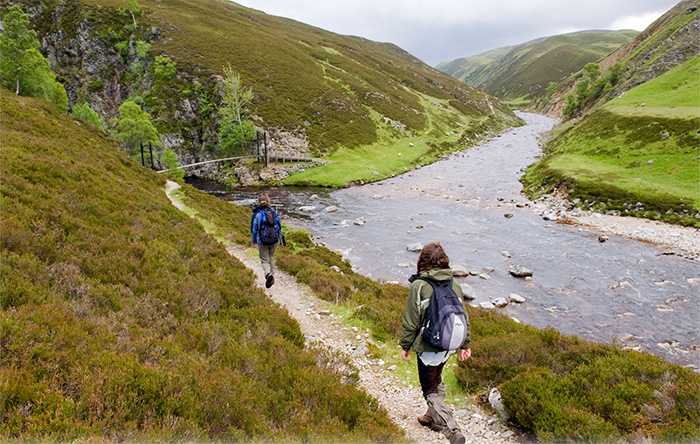
Aim
The aim of this guide is to provide guidance on the legal aspects of managing public access and how to encourage cooperation between all access takers, professionals, employees and members of the public.
Introduction
Deer stalking and countryside recreation activities such as walking and climbing are long established in Scotland and both are of social and economic importance. These interests have much in common and usually co-exist with few problems. Walkers and stalkers enjoy Scotland’s countryside for much the same reasons and often share a passion for our wildlife, including deer.
Although commonly thought of as a largely upland issue, deer populations in woodlands and around towns increase the possibilities for deer managers and access takers to come into contact. Such contact is an ideal opportunity to explain sustainable deer management principles and practice to the benefit of all who enjoy Scotland’s outdoors.
Communication is the key to ensuring that these interests can co-exist and signage, although other methods are available, is likely to be a key part of the land manager’s communication strategy.
Legal background
- The Land Reform (Scotland) Act 2003 formalised the right of responsible public access to Scotland’s outdoors. With these rights came responsibilities on land managers and access takers alike and these are explained in the Scottish Outdoor Access Code.
Generally, there are some key principles that should be adhered to:
- Access takers: there is a responsibility on users to respect any reasonable requests by land managers to enable land management operations to take place, such as avoiding particular areas. People are most likely to follow a request if it is clear and is sympathetic to walkers’ aspirations and they understand why the request is being made.
- Land managers: if there is a requirement for land managers to identify areas that may need to be avoided, the information supplied should relate to specific days and apply to the minimum necessary area. This is more likely to encourage a positive response than a more general message.
Information should include suggested alternative routes of a similar nature which will not interfere with stalking. These should normally start from the same location or, failing that, nearby.

Upland Issues
Upland specific issues have largely been addressed through the stalking sub-group of the National Access Forum. Comprehensive guidance on access management and the use of signs has been produced which is targeted at upland situations.
Lowland/woodland Issues
The presence of deer populations in woodland and around towns, together with increased public access, may result in more contact between access takers and deer managers.
Although signage guidance relating to other land management activities has been produced , no specific guidance has been produced for these situations, some general principles apply:
- Deer managers must exercise extreme vigilance since it cannot be assumed that any access takers will not be present at any time during the 24 hour period.
- Deer managers need to be aware of their personal safety and firearms security, and should quietly and calmly walk away from situations of conflict.
- Careful consideration should be given to the use of high seats . Vandalism, unauthorised use and the potential for increased public alarm or disquiet due to the elevated position of deer managers. If any dialogue occurs with access takers, deer managers should leave the high seat and return to the ground.
- Deer managers should be aware of the potential alarm or disquiet that can be caused by the presence of firearms and carcasses.
- Deer managers attempting to hide in cover as access takers pass by may cause alarm.
Opportunities
Communications with other countryside users offer deer managers an opportunity to share information on sustainable deer management in Scotland. Much of the perceived conflict between land and deer managers and other access takers can be attributed to a lack of understanding of each others needs, objectives and aspirations.
Communication offers the opportunity to explain the public benefit of culling deer; the potential deer welfare issues from disturbance at certain times of year, and the need to keep dogs under control.
There are also other opportunities to engage positively with all outdoor recreation users. These range from provision of facilities such as paths to manage access, car parking and toilets, to revenue generating opportunities such as wildlife watching activities, catering outlets, or opportunities to market local produce such as venison directly to members of the public.
